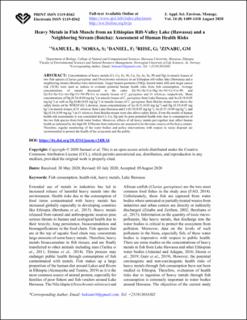Heavy Metals in Fish Muscle from an Ethiopian Rift Valley Lake (Hawassa) and a Neighboring Stream (Boicha): Assessment of Human Health
Journal article, Peer reviewed
Published version
Permanent lenke
https://hdl.handle.net/11250/2830585Utgivelsesdato
2020Metadata
Vis full innførselSamlinger
Originalversjon
Journal of Applied Sciences and Environmental Management. 2020, 24 (8), 1409-1418. 10.4314/jasem.v24i8.16Sammendrag
Concentrations of heavy metals (Cr, Co, Fe, Ni, Cu, Zn, As, Se, Pb and Hg) in muscle tissues of two fish species (Clarias gariepinus and Oreochromis niloticus) in an Ethiopian rift-valley lake (Hawassa) and a neighboring stream (Boicha) were determined. Target hazard quotients (THQ), hazard index (HI) and target cancer risk (TCR) were used as indices to evaluate potential human health risks from fish consumption. Average concentrations of metals decreased in the order Zn>Fe>Se>Cu>Hg>As>Ni>Cr>Co>Pb and Zn>Fe>Se>Cu>As>Hg>Cr>Ni>Pb>Co in muscle tissues of C. gariepinus and O. niloticus, respectively. Mean concentrations of Hg (0.34+0.04 mg kg-1) in muscle tissues of C. gariepinus from Lake Hawassa, and As (0.18+0.05 mg kg-1) as well as Hg (0.46+0.03 mg kg-1) in muscle tissues of C. gariepinus from Boicha stream were above the safety limits set by WHO/FAO. Likewise, mean concentrations of As (0.31+0.03 mg kg-1) and Hg (0.19+0.05 mg kg-1) in muscle tissues of O. niloticus from Lake Hawassa and Cr (0.19+0.03 mg kg-1), As (0.33 +0.04 mg kg-1), and Hg (0.34+0.09 mg kg-1) in O. niloticus from Boicha stream were also above safety limits. From the results of human health risk assessments it was concluded that Cr, Cu, Hg and As pose potential health risks due to consumption of the two fish species from both water bodies. Moreover, effects of all heavy metals put together may affect human health as indicated by the high HI. Effluents from industries are assumed to be the main sources of the heavy metals. Therefore, regular monitoring of the water bodies and policy interventions with respect to waste disposal are recommended to protect the health of the ecosystem and the public.
